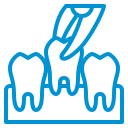Tooth Extraction
in Lucknow
When it comes to dental procedures, tooth extraction — or having teeth “pulled” — is among patients’ most dreaded prospects. Also referred to as exodontia, tooth extraction involves removing a tooth from its socket in the jaw bone. Before we consider extraction, dentist at Mint Dental Dr. Atul Singh make every effort to try to repair and restore your tooth. However, sometimes extraction is necessary.



Reasons for Extraction
Severe Tooth Damage/Trauma
Some teeth have such extensive decay and damage (broken or cracked) that repair is not possible. For example, teeth affected by advanced gum (periodontal) disease may need to be pulled. As gum disease worsens, the tooth — supported by less surrounding bone — often loosens to such an extent that extraction is the only solution.
Malpositioned/Nonfunctioning Teeth
Orthodontic Treatment
Extra Teeth
Radiation
Chemotherapy
Organ Transplant
The Two Types of Extraction

Simple Extractions

Surgical Extractions

The Tooth Extraction Process
At the time of extraction the Lucknow dentist Dr. Atul Singh will need to numb your tooth, jaw bone and gums that surround the area with a local anesthetic.
During the extraction process you will feel a lot of pressure. This is from the process of firmly rocking the tooth in order to widen the socket for removal.
You feel the pressure without pain as the anesthetic has numbed the nerves stopping the transference of pain, yet the nerves that transmit pressure are not profoundly affected.
If you do feel pain at any time during the extraction please let us know right away.
Home Instructions After the Removal of a Single Tooth
- After tooth extraction, it’s important for a blood clot to form to stop the bleeding and begin the healing process. Bite on a gauze pad for 30-45 minutes immediately after the appointment. If the bleeding or oozing still persists, place another gauze pad and bite firmly for another 30 minutes. You may have to do this several times to staunch the flow of blood.
- After the blood clot forms it is important to not disturb or dislodge the clot. Do not rinse vigorously, suck on straws, smoke, drink alcohol or brush teeth next to the extraction site for 72 hours. These activities may dislodge or dissolve the clot and hinder the healing process. Limit vigorous exercise for the next 24 hours, as this increases blood pressure and may cause more bleeding from the extraction site.
- After the tooth is extracted you may feel some pain and experience some swelling. An ice pack or an unopened bag of frozen peas or corn applied to the area will keep swelling to a minimum. Take pain medications as prescribed. The swelling usually subsides after 48 hours.
- Use pain medication as directed. Call our clinic if the medication doesn’t seem to be working. If antibiotics are prescribed, continue to take them for the indicated length of time even if signs and symptoms of infection are gone. Drink lots of fluids and eat nutritious, soft food on the day of the extraction. You can eat normally as soon as you are comfortable.
- It is important to resume your normal dental routine after 24 hours. This should include brushing and flossing your teeth at least once a day. This will speed healing and help keep your mouth fresh and clean.
- After a few days you should feel fine and can resume your normal activities. If you have heavy bleeding, severe pain, continued swelling for 2-3 days, or a reaction to the medication, call Mint Dental immediately.
A top-rated clinical team
At Mint Dental keeping your smile healthy and beautiful is our top priority!
Under the leadership of Dr. Atul Singh (MDS) we provide you with dental care that is effective, gentle, and customized to meet your specific dental needs.
Our team stays a step ahead of the game with advanced training and dental services to make sure you receive nothing less than the best possible care.

